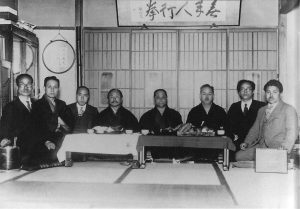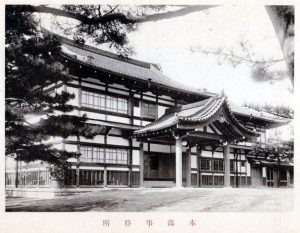A Brief Timeline of Karate
1911
The term karate first used to define the style of Okinawan martial arts being taught at Middle Schools in Japan.
1920’s
Okinawan Karate Masters travel to mainland Japan to live and teach karate.
1930’s
Karate Masters seek to be officially recognised by the National Government body overseeing Martial Arts in Japan. Coloured Belts and Black Belt Dan grades are introduced like those used in Judo.
1950’s
Karate spread beyond Japan, first by returned servicemen bringing books and other materials back from Japan to the United States and Europe.
1960’s
Japanese instructors began to travel and emigrate all over the world teaching karate wherever they were invited. The Japanese and European Karate Federations were formed off the back of the 1964 Tokyo Olympics & first time Judo appears in the Olympics.
1970’s
Worldwide Karate Organisation began to formalise with the view to oversee karate instruction internationally and seek inclusion in the Olympics.
1980’s
Karate continues to grow and karate masters start to work in Hollywood, culminating in more karate on the big screen including in 1984, The Karate Kid. Which encourages more children to start learning karate.
2008
The international karate body (WUKO) is renamed the World Karate Federation (WKF) and continues to push for Olympic inclusion.
2016
The IOC announces Karate is to be included at the Tokyo 2020 Olympics as a demonstration sport.
2021
Karate is showcased as a demonstration sport in the 2020 Tokyo Olympics.
And now onto a Brief History of Karate
This is a very, very brief history and origin story of karate based on my research and understanding to date.
Karate as we know it originated in Japan in and around the 1920s – 1930’s. This is when several of the karate masters of Okinawa travelled to the Japanese mainland and began to teach there. The term karate was first used in 1911-1912 when Okinawan Boxing or Okinawan Hand was taught in Japanese Middle Schools. In Japan the characters for karate were 唐手 (Tang Chinese, Hand).
However in Japan, in the 1930’s anything to do with China was very unpopular, so in order to see the art grow in Japan, the karate masters decided to change the first character to 空 (empty), so karate came to be 空手 (empty, hand) instead.
Let’s jump back a step, the karate masters all came from the group of islands known as Okinawa, which is a territory controlled by Japan. Okinawa sits in the East China Sea between Japan and China. For hundreds of years Okinawa traded and interacted with both Japan and China.

Source: Google Maps
While there has always been fighting arts practiced in Okinawa the beginnings of what would become karate formalised during the 17th Century when the Shimazu Clan of Satsuma prefecture in Japan took control of the islands. Weapons were prohibited and the nobility and royal bodyguards of Okinawa continued to refine their unarmed combat skills in secret. These teachings were passed down between family members and select few worthy students.
At the turn of the 20th Century the Japanese government had concerns over the general fitness and health of the population and especially school children. The government also noted after testing of the population, in particular the military, that Okinawans that studied karate where particularly strong and healthy. Looking to encourage skills and physical education a karate Master Itosu Anko sought to have the school children in Okinawa practice martial arts to boost their physical fitness.
Similarly Kano Jigoro the founder of Judo was looking to introduce Judo into schools on mainland Japan around the same time. Both teachers sought to modify their martial arts training to suit school children changing techniques and training drills more suited to sports combat rather than military combat.
By the 1920’s karate practitioners in Okinawa were meeting to train, and many students of the instructors at the turn of the century were now setting up karate clubs to train together and teach their arts to the public and different bodies from the police, to schools and others. Some of these instructors travelled to mainland Japan to showcase the Okinawan Martial Art, with some moving there to live permanently and teach. This included Funakoshi, Mabuni, Miyagi among others.

Master of Karate in Tokyo c.1930, Source: Wikipedia – https://en.wikipedia.org/wiki/Karate
In the 1930’s these karate instructors sort to be recognised by the Dai Nipon Butoku Kai, the government body charged with recognising and certifying all martial arts in Japan. In order to be officially recognised as a martial art the karate schools needed to adopt a formalised list of techniques and grades for students and a standardised testing system. This is where they adopted the judo belt colours and dan grades for black belts, and where the stances, techniques and strikes became formalised for a Japanese audience.

Dai Nippon Butoku Kai c.1932, Source: Wikipedia – https://en.wikipedia.org/wiki/Dai_Nippon_Butoku_Kai
During the 1950s karate began to spread beyond Japan, firstly to the United States and then to Europe, Returned Servicemen having seen karate demonstrations in Japan and Okinawa, where the US military created an air base, brought the experience to the West, including books on martial arts, and Japanese instructors travelled to share their martial arts experience. Two main western influencers that shared karate where Donn Dragger in the US and Henry Plee in France.
By the 1960’s many Japanese karate practitioners were travelling and emigrating all over the world teaching karate to all that were interested. Differing schools and styles travelling to different places, based on invitations and student interest.
Back in Japan the Japan Karate Federation (JKF) was formed in 1964 to coincide with the Tokyo Olympics. In France, the European Karate Federations were also formed to bring organisation to the sport and organise competitions for karate.
During the 1970s Worldwide Karate organisations began to form, with the view to oversee the growth of karate and to seek inclusion in the Olympic Games.
Karate continued its growth in the United States with several karate specialists making their way to Hollywood, which lead to more karate techniques seen on screen, including the 1984 film the Karate Kid, which saw and explosion in interest in the martial art, not only from adults as it had been during the 60s and 70s, but now an interest from children as well.

Karate Kid (1984), Source: https://en.wikipedia.org/wiki/The_Karate_Kid
In 2008 World Union of Karate Do Organisations (WUKO) became the World Karate Federation (WKF) and sought inclusion in the Olympics as a unified governing body. In 2016 the IOC announced that karate would be included in the 2020 Tokyo Olympics as a demonstration sport.
References:
Mabuni, Kenei. Empty Hand: The Essence of Budo Karate (2009)
Cramer, M. The History of Karate and the Masters who made it (2018)
Stevens , J. The Way of Judo: A Portrait of Jigoro Kano and His Students (2013)
Swift, J. Itosu Anko: Saviour of a Cultural Heritage (2019)
Mabuni, Kenwa. Karatedo Kempo (2007)
